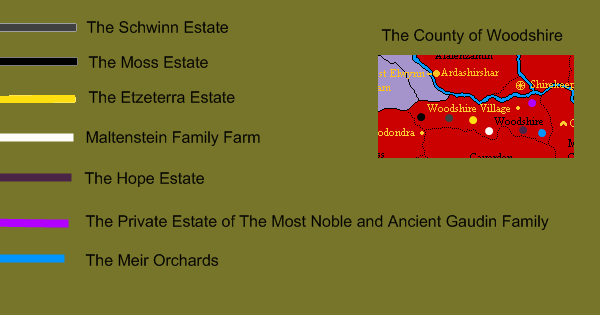Woodshire: Difference between revisions
No edit summary |
|||
| Line 6: | Line 6: | ||
largecity = none | | largecity = none | | ||
title = The Count | | title = The Count | | ||
government = Feudal | government = Feudal | | ||
leader = | leader = Discontinued | | ||
language = English | | language = English | | ||
religion = Cedrism/Christianity/Judaism | | religion = Cedrism/Christianity/Judaism | | ||
}} | }} | ||
The County of Woodshire | The '''County of Woodshire''' was a former [[subdivision]] of [[Brookshire]] and for much of its history formed part of the [[Earldom]] of [[Dolor]]. Its first leader of note was Count [[Thomas Gaudin]], appointed by [[Erik Mortis]]. Its culture was mainly based around agriculture and included many religious aspects from its largest religions; Cedrism, Chrsitianity, and Judaism. | ||
==Land== | ==Land== | ||
The | The county comprised a portion of land located north of Caverden, south of Shirekeep, west of Monty Crisco, etc. It was also located just east of [[Ashkenatza]] and a large community of Ashkenazi Jews had long been established within the capital city, Woodshire Village. The land is generally flat and suited for agricultural work. | ||
==History== | ==History== | ||
Most of the early history of the | Most of the early history of the county is unknown. The population only learned basic reading and writing skills after refugees from Thither Tellia began to pour in during conflict between Tellia and Ashkenatza. Today, due to the efforts of Jewish immigrants and Count Gaudin, the area is only slightly less developed than its neighboring counties. | ||
==Culture== | ==Culture== | ||
Woodshire's culture stems mostly from | Woodshire's culture stems mostly from its not-so-peaceful past conflicts. The region was ruled, for many years, by two families - the Etzetteras and the Maltensteins. The families were bitter rivals - fighting for economic and military dominance. The fighting was eventually stopped when two of the heirs to the family fortunes secretly wed in the dead of night. Thomas Gaudin claimed descent from these original Woodshirer peace-makers. | ||
The County's flag is generally smeared with blood, or blood-like paint, to indicate respect and honor for the fallen soldiers who were under the command of the Etzetteras and Maltensteins. Most of the county's citizens can trace their lineage to several who fought in these conflicts. | The County's flag is generally smeared with blood, or blood-like paint, to indicate respect and honor for the fallen soldiers who were under the command of the Etzetteras and Maltensteins. Most of the county's citizens can trace their lineage to several who fought in these conflicts. | ||
| Line 28: | Line 28: | ||
==Government== | ==Government== | ||
Under Count Thomas Gaudin, the county was ruled autocratically. All power flowed through his edicts and decrees and the vast majority of its citizens were employed by the county authorities to work in agriculture or military positions. All that was produced was handed in to the Count for fair redistribution. Some rabble-rousers in the Village claimed that much of this produce, including apples, wheat, and pecans, was actually sold by the Count for his own personal profit, but the Count strenuously denied the allegations, claiming that all food was redistributed to the citizens according to their need. | |||
Count Thomas' rule was notable for public works. By his order, the citizens constructed two palaces, a theater, a public forum, and the University of Woodshire. Other important public places constructed before the arrival of the Count included several religious institutions and buildings. | |||
==Militia== | ==Militia== | ||
Leaning heavily on the development and ideas of | Leaning heavily on the development and ideas of its neighbor, Monty Crisco, Woodshire developed a small militia of 500 highly trained guards. They were garrisoned at Maltenstein Fortress in central Woodshire, although small groups were also stationed in Woodshire Village and with the Count. | ||
==Economy== | ==Economy== | ||
The economy | The economy was dominated completely by two things; the whims of the Count and agriculture. Popular exports included Apples, Pears, Pecans, and timber. Industry was limited heavily except within The Village, where it has begun thriving in recent years. The Village was also known for its signature Chocolate Shop, still named after the family that founded it, Chocolate Etzettera. | ||
Several families | Several families were granted estates by the Count, under orders to employ all citizens in their regions for agricultural work on their estates. | ||
[[Image:Woodshire.png]] | [[Image:Woodshire.png]] | ||
==Dissolution== | |||
In 4581 ASC, the county fell under the control of the undead ruler of neighbouring [[Caverden]], [[Anthrazita von Rossheim-Maltenstein]], a former native of Woodshire. The county was subsequently incorporated within Rossheim-Maltenstein's [[Overdolor|Lichgraviate of Overdolor]] and in 4638 ASC, was merged with Caverden. | |||
Since 4696 ASC, Woodshire has been a [[riding]] of the [[Lichshire|Principality of Lichshire]]. | |||
[[category: Subdivision]] | |||
[[category: Brookshire]] | |||
[[category: Lichshire]] | |||
[[category: Dolor]] | |||
[[category: Counties]] | |||
Latest revision as of 14:10, 15 June 2012
The County of Woodshire was a former subdivision of Brookshire and for much of its history formed part of the Earldom of Dolor. Its first leader of note was Count Thomas Gaudin, appointed by Erik Mortis. Its culture was mainly based around agriculture and included many religious aspects from its largest religions; Cedrism, Chrsitianity, and Judaism.
Land
The county comprised a portion of land located north of Caverden, south of Shirekeep, west of Monty Crisco, etc. It was also located just east of Ashkenatza and a large community of Ashkenazi Jews had long been established within the capital city, Woodshire Village. The land is generally flat and suited for agricultural work.
History
Most of the early history of the county is unknown. The population only learned basic reading and writing skills after refugees from Thither Tellia began to pour in during conflict between Tellia and Ashkenatza. Today, due to the efforts of Jewish immigrants and Count Gaudin, the area is only slightly less developed than its neighboring counties.
Culture
Woodshire's culture stems mostly from its not-so-peaceful past conflicts. The region was ruled, for many years, by two families - the Etzetteras and the Maltensteins. The families were bitter rivals - fighting for economic and military dominance. The fighting was eventually stopped when two of the heirs to the family fortunes secretly wed in the dead of night. Thomas Gaudin claimed descent from these original Woodshirer peace-makers.
The County's flag is generally smeared with blood, or blood-like paint, to indicate respect and honor for the fallen soldiers who were under the command of the Etzetteras and Maltensteins. Most of the county's citizens can trace their lineage to several who fought in these conflicts.
The County's religious groups play an important role in everyday life for Woodshirers. Cedrism, Judaism, and Christianity make up the largest religious groups, respectively.
Government
Under Count Thomas Gaudin, the county was ruled autocratically. All power flowed through his edicts and decrees and the vast majority of its citizens were employed by the county authorities to work in agriculture or military positions. All that was produced was handed in to the Count for fair redistribution. Some rabble-rousers in the Village claimed that much of this produce, including apples, wheat, and pecans, was actually sold by the Count for his own personal profit, but the Count strenuously denied the allegations, claiming that all food was redistributed to the citizens according to their need.
Count Thomas' rule was notable for public works. By his order, the citizens constructed two palaces, a theater, a public forum, and the University of Woodshire. Other important public places constructed before the arrival of the Count included several religious institutions and buildings.
Militia
Leaning heavily on the development and ideas of its neighbor, Monty Crisco, Woodshire developed a small militia of 500 highly trained guards. They were garrisoned at Maltenstein Fortress in central Woodshire, although small groups were also stationed in Woodshire Village and with the Count.
Economy
The economy was dominated completely by two things; the whims of the Count and agriculture. Popular exports included Apples, Pears, Pecans, and timber. Industry was limited heavily except within The Village, where it has begun thriving in recent years. The Village was also known for its signature Chocolate Shop, still named after the family that founded it, Chocolate Etzettera.
Several families were granted estates by the Count, under orders to employ all citizens in their regions for agricultural work on their estates.
Dissolution
In 4581 ASC, the county fell under the control of the undead ruler of neighbouring Caverden, Anthrazita von Rossheim-Maltenstein, a former native of Woodshire. The county was subsequently incorporated within Rossheim-Maltenstein's Lichgraviate of Overdolor and in 4638 ASC, was merged with Caverden.
Since 4696 ASC, Woodshire has been a riding of the Principality of Lichshire.

